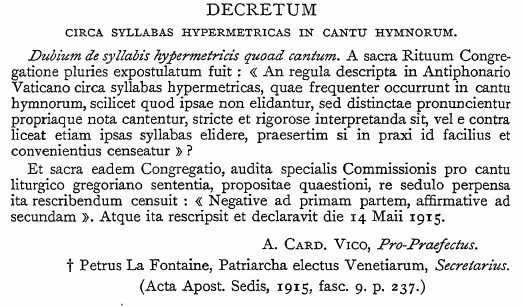Bells of Notre-Dame ring out for first time since 2019 fire | AFP

Catholic musicians gathered to blog about liturgy and life
The Church Music Association of America commissioned a new Mass Ordinary setting in preparation for the 2024 Sacred Music Colloquium, held in Champaign, IL this summer.

Daniel Knaggs‘ Misa Santiago was performed for the first time this summer.
Here is a video recording of the Señor, ten piedad (Kyrie) from that Mass as sung by Colloquium participants this summer:
For access to the entire Mass setting, please visit our Spanish Resources page.
The Church Music Association of America is pleased to announce that several virtual sessions on various topics are being offered in the coming months.
Construyendo un programa de Música Sacra en su parroquia
Descubra cómo una implementación gradual puede traer grandes cambios.
Panelistos: José Ballón Mario Fayas Gustavo Zayas
Esta sesión de una hora será el 16 de septiembre de 2024 a las 20 horas (EDT).
Registro disponible para todos; No se requiere membresía CMAA.
 Zoom Session for Priests
Zoom Session for Priests
Discuss how to foster a great Sacred Music program in your parish with our panel of priests. Panelists include: Rev. David Carter, Rev. Michael Connelly, Rev. Robert Pasley, Rev. Alfredo Porras, and Rev. Brent Stull, with Rev. Pasley moderating.
This session is open to priests only; CMAA membership is not required.
This one-hour session will take place on September 26, 2024, 8 pm Eastern (5 pm Pacific).
 The Basics of Gregorio
The Basics of Gregorio
Join Dr. Charles Weaver, as he leads you through the basics of using the excellent tool for Gregorian chant engraving – Gregorio.
This session is open to CMAA Members.
This one-hour session will take place on October 21, 2024, 8 pm Eastern (5 pm Pacific).
 Troubleshooting Vocal Problems
Troubleshooting Vocal Problems
Join Dr. MeeAe Cecilia Nam in this one-hour session to learn more about vocal problems and what to do about them.
This session is open to CMAA Members.
This session will take place on November 4, 2024, 8 pm Eastern (5 pm Pacific).
 Plan a Summer Chant Camp
Plan a Summer Chant Camp
Join in the discussion with our panelists to learn how to plan your own parish chant camp for next summer. Mary Ann Carr Wilson, Lisa Knutson, and Anders Bergmann generously share their expertise and experience with registrants.
This one-hour session will take place on November 18, 2024 at 8 pm Eastern (5 pm Pacific).
This session is open to all CMAA Members.
Register for any of these events here: REGISTRATION
A new collection of plainchant in English is now available, in the Saint John’s Gradual edited by Rev. Steven Lewis of the Diocese of Rochester. The collection is named for St. John’s Seminary in Boston, where he studied, and it is available for download from the Seminary’s website, complete with ecclesiastical approbation by Cardinal O’Malley.
This collection provides simple, singable English versions of the graduals, tracts, and alleluias, so it serves as a complement to works such as Simple English Propers by Adam Bartlett or Fr. Samuel Weber’s The Proper of the Mass, which provide settings of entrance, offertory, and communion chants. The texts come from various liturgical books and chant editions.
Congratulations to Fr. Lewis on this accomplishment!
Seton Route
Juan Diego Route
Marian Route
Serra Route
The 4 Eucharistic Revival Processions are in full swing, fulfilling the Year of Parish Revival.
(31) 2024 National Eucharistic Pilgrimage Kicks Off | EWTN News Nightly – YouTube
Here are highlights from each of the routes.
Serra Route: Opening Mass from the Cathedral of St. Mary of the Assumption in San Francisco
(31) NATIONAL EUCHARISTIC PILGRIMAGE OPENING MASS FROM SAN FRANCISCO – 2024-05-19 – YouTube
Marian Route: Opening Mass in the Diocese of Crookston
(31) Star of the North Eucharistic Congress 2024 – YouTube
Seton Route: The Procession begins
National Eucharistic Pilgrimage – Seton Route Kickoff in New Haven (youtube.com)
Juan Diego Route: Mass from Brownsville, live at this writing
CONCLUDING MASS NATIONAL EUCHARISTIC PILGRIMAGE (youtube.com)
Occasionally in classic Latin hymns we find texts that don’t fit the poetic meter perfectly but have an extra syllable, and these are often notated so as to draw attention to the discrepancy, as here (“digitus”) in the Veni Creator Spiritus:

Some choir directors adjust these “hypermetric syllables” to fit the meter: that is, they may “elide” syllables by omitting the vowel of one syllable and combining the rest of that syllable with the next (or the previous one!). For example, in the doxology at the end of a long-meter hymn, the phrase “cum Patre et almo Spiritu” can be sung in eight syllables as “cum Patr-et almo Spiritu”. On the other hand, some choir directors sing these lines exactly as notated, out of a sense of duty to sing the hymn as directed in the church-approved book.
Today I stumbled on this document in the old (1949/1960) Antiphonale Romanum (page 64*), which addresses the concern about what is permitted.

The question addressed to the Congregation of Rites (back in 1915) was whether these lines should be pronounced distinctly and the added notes sung rigorously as indicated in the Antiphonale, or whether it was permitted to elide those syllables; and the answer from the Congregation came back, “Negative to the first part; affirmative to the second”; that is: it is not required to interpret those lines rigorously, and it is permitted to elide the affected syllables.
So when a text occasionally doesn’t conform to the meter of its tune, it’s fine to make it fit: I hope this helps ease any scruples of worried singers.